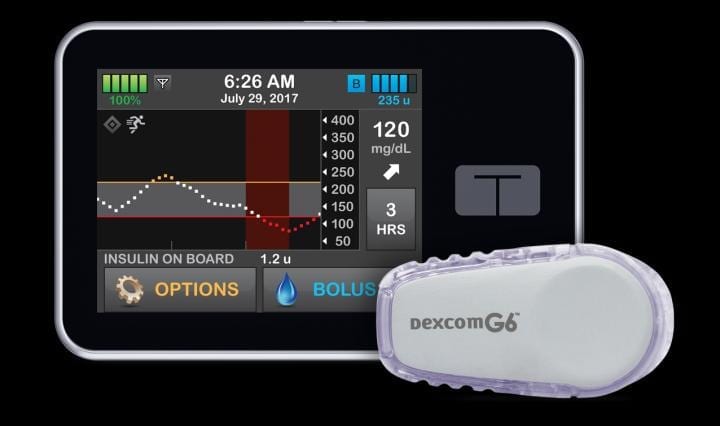
NIH-funded study of people with type 1 diabetes shows safety, efficacy benefits of new system
A multicenter randomized clinical trial evaluating a new artificial pancreas system – which automatically monitors and regulates blood glucose levels – has found that the new system was more effective than existing treatments at controlling blood glucose levels in people with type 1 diabetes. The trial was primarily funded by the National Institute of Diabetes and Digestive and Kidney Diseases (NIDDK), part of the National Institutes of Health.
The study showed that the system improved participants’ blood glucose control throughout the day and overnight. The latter is a common but serious challenge for children and adults with type 1 diabetes, since blood sugar can drop to dangerously low levels when a person is asleep. The research is published in the New England Journal of Medicine.
The artificial pancreas, also known as closed-loop control, is an “all-in-one” diabetes management system that tracks blood-sugar levels using a continuous glucose monitor (CGM) and automatically delivers the hormone insulin when needed using an insulin pump. The system replaces reliance on testing by fingerstick or CGM with separate delivery of insulin by multiple daily injections or a pump.
The International Diabetes Closed-Loop (iDCL) Study involves five separate artificial pancreas clinical protocols implemented by 10 research centers in the United States and Europe. This six-month study was the third phase in a series of trials. It was conducted with participants living their usual day-to-day lives, so the researchers could best understand how the system works in typical daily routines.
“Testing the safety and effectiveness of new technologies in real-world settings is critical to prove the usability of these systems by people with diabetes to achieve a better daily control of their blood glucose levels,” said Guillermo Arreaza-Rubín, M.D., director of NIDDK’s Diabetes Technology Program and project scientist for the study. “Earlier technologies have made the management of type 1 diabetes easier, and this research shows that this artificial pancreas system has the potential to improve health of people living with type 1 diabetes, while also potentially lifting much of the burden of care from those with the disease and their caregivers.”
This iDCL protocol enrolled 168 participants age 14 or older with type 1 diabetes. They were randomly assigned to use either the artificial pancreas system called Control-IQ or sensor-augmented pump (SAP) therapy with a CGM and insulin pump that did not automatically adjust insulin throughout the day. Participants had contact with study staff every two to four weeks to download and review device data. No remote monitoring of the systems was done, so that the study would reflect real-world use.
The researchers found that users of the artificial pancreas system significantly increased the amount of time with their blood glucose levels in the target range of 70 to 180 mg/dL by an average of 2.6 hours per day since beginning the trial, while the time in range in the SAP group remained unchanged over six months. Artificial pancreas users also showed improvements in time spent with high and low blood glucose, hemoglobin A1c, and other measurements related to diabetes control compared to the SAP group. High adherence to device use in both groups and 100% participant retention were important strengths of the study. During the study, no severe hypoglycemia events occurred in either group. Diabetic ketoacidosis occurred in one participant in the artificial pancreas group due to a problem with equipment that delivers insulin from the pump.
The Control-IQ technology was derived from a system originally developed at the University of Virginia, Charlottesville, (UVA) by a team led by Boris Kovatchev, Ph.D., director of the UVA Center for Diabetes Technology with funding support from NIDDK. In this system, the insulin pump is programmed with advanced control algorithms based on a mathematical model that uses the person’s glucose monitoring information to automatically adjust the insulin dose. Tandem Diabetes Care has submitted the results to the U.S. Food and Drug Administration for approval to market the Control-IQ system.
“This artificial pancreas system has several unique features that improve glucose control beyond what is achievable using traditional methods,” said Kovatchev. “In particular, there is a special safety module dedicated to prevention of hypoglycemia, and there is gradually intensified control overnight to achieve near-normal blood sugar levels every morning.”
Kovatchev was co-lead author of the study with colleagues Sue A. Brown, M.D., of UVA and Roy Beck, M.D., Ph.D., from the Jaeb Center for Health Research, Tampa, Florida, which was the coordinating center for the study.
“Artificial pancreas technology has tremendous potential to improve the day-to-day lives of people with type 1 diabetes,” said NIDDK Director Griffin P. Rodgers, M.D. “By making management of type 1 diabetes easier and more precise, this technology could reduce the daily burden of this disease, while also potentially reducing diabetes complications including eye, nerve and kidney diseases.”
Learn more: Artificial pancreas system better controls blood glucose levels than current technology
The Latest on: Artificial pancreas
[google_news title=”” keyword=”artificial pancreas” num_posts=”10″ blurb_length=”0″ show_thumb=”left”]
via Google News
The Latest on: Artificial pancreas
- Best dog food for sensitive stomachs, according to expertson April 26, 2024 at 10:46 am
We interviewed experts, who explained that the best dog foods for sensitive stomachs all feature easy-to-digest formulas in a range of flavors and food types.
- Microscopic Colitison April 25, 2024 at 2:29 pm
Microscopic colitis is inflammation of the colon's lining that causes chronic watery diarrhea. Thankfully, there are effective treatments available.
- Morecambe vicar to mark his 70th birthday with 140-mile walk in aid of charityon April 23, 2024 at 8:43 am
Morecambe clergyman John Simmons plans to celebrate his 70th birthday in an unusual way.
- BEST & BRIGHTEST: A journey from homeless to excellenceon April 23, 2024 at 4:00 am
Blair Minnard struggled through her first year of middle school as her family lived in three local motels while homeless for eight months but bounced back to become a top ...
- 13-year-old dies after shooting at Raleigh apartment complexon April 22, 2024 at 8:59 am
April 7 marks six months since Hamas unleashed a deadly and unprecedented attack on Israel, which subsequently declared war against the militant group. Here's where the conflict stands. Over 40,000 ...
- Siblings with unique gene mutation offer insights into type 1 diabetes treatmenton April 20, 2024 at 10:51 pm
Two siblings who have the only known mutations in a key gene anywhere in the world have helped scientists gain new insights that could help progress the search for new treatments in type 1 diabetes.
- VA to largely end animal testing on dogs, cats within two yearson April 18, 2024 at 11:32 am
The Department of Veterans Affairs is slated to largely end testing on dogs, cats and nonhuman primates within the next two years.
- AI speeds up drug design for Parkinson's by ten-foldon April 17, 2024 at 2:00 am
Researchers have used artificial intelligence techniques to massively accelerate the search for Parkinson's disease treatments. The researchers, from the University of Cambridge, designed and used an ...
- Meet the Dancer Determined to Prove It Can Be Easier to Live With Diabeteson April 16, 2024 at 9:04 am
We speak to Type 1 Diabetic, Lydia Brian about her diagnosis and her new app to help those also with the disease.
- NHS to roll out artificial pancreas developed at Addenbrooke’s Hospital in Cambridgeon April 16, 2024 at 1:37 am
An artificial pancreas developed at Addenbrooke’s Hospital is being rolled out by the NHS for patients with type one diabetes.
via Bing News










